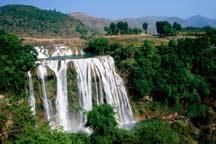Guizhou Province
2009-09-10 14:44 BJTSpecial Report: 60th Anniversary of PRC |
Watch Video

 Play Video
Play Video
Now, let's turn to today's introduction to Chinese provinces, autonomous regions, and municipalities. Our focus is Guizhou Province.
Guizhou Province is situated in southwest China, and its capital city is Guiyang. It covers 176,000 square kilometers, with a population of about 35 million.
Guizhou is a province with impressive natural scenery, remarkable national customs, a brilliant history, and a mysterious landscape.
It is one of the provinces that is home to the greatest number of ethnic minority groups, such as the Yao, Miao, Bouyei, Yi and Shui. More than 15 ethnic minority groups call Guizhou home, and most of the amazing scenic areas are located in these areas. You can discover the rich and varied folk customs and cultures of different minority ethnic groups.
Among them, Miao embroidery has a very long history. Embroidery is a kind of traditional handicraft,which weaves figures on fabric with a needle and colorful thread.
One of Guizhou's major tourist attractions are the Huangguoshu falls. The falls are the largest in China, dropping 74 meters and measuring 81 meters across. The thunder of the falls can be heard for some distance, and the falls are at their most spectacular about five days after the heavy rains that come between May and October.
The Zhijin Cave Scenic Spot is another highlight, known as "The Museum of Karst Formations."
In addition, there are numerous beautiful landscapes across the province.
Guizhou is also the home of the Moutai Distillery. It enjoys an international reputation as "China's National Wine."
Zunyi is well-known for its place in the history of the Communist Party of China. During the Long March in 1935, an enlarged Politburo meeting of the CPC Central Committee was held here and Chairman Mao Zedong entered the Party leadership which salvaged the Chinese revolution from defeat to victory that finally led to the establishment of the New China in 1949.
Editor: Zhang Ning | Source: CCTV.com
 Mail
Mail Share
Share Print
Print


 Video
Video









 2009 China Central Television. All Rights Reserved
2009 China Central Television. All Rights Reserved